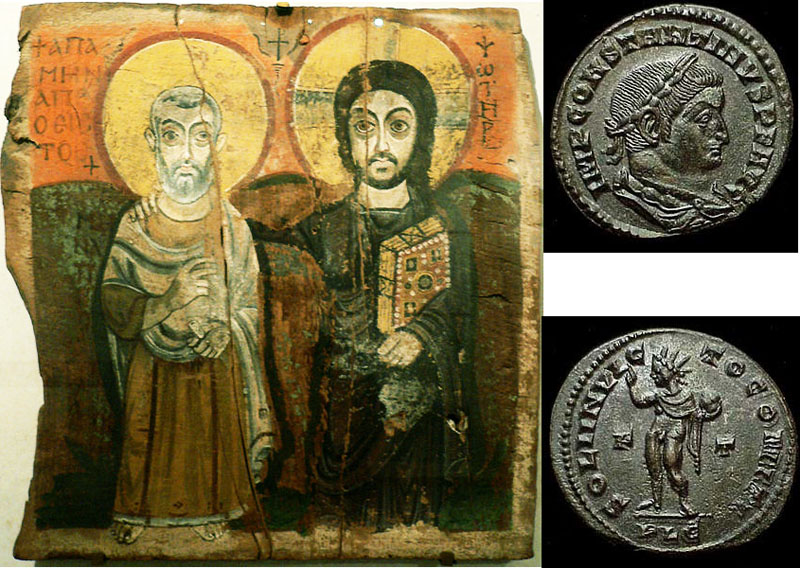
WAS THE CELTIC CROSS ORIGINALLY A PAGAN, NON-CHRISTIAN SYMBOL?
The historical evidence shows that Roman Christianity adopted the cross as a religious symbol at quite a late epoch, whereas Coptic (Egyptian) or Gnostic forms of very early Christianity (persecuted by the Romans) made some use of the cross after about the 2nd century AD. Even at that, there was still considerable division and infighting amongst varied Christian sects or persuasions of that time as to whether or not an instrument of such inhumane torture was appropriate as a symbol of Christian worship.
Ireland remained totally aloof from and uninfluenced by the Roman armies that conquered England. They were also isolated from and uninfluenced by the latter, militant Roman form of Christianity that emerged in the 4th century AD, under the patronage of Constantine I. This Roman State variation didn't manage to become dominant in Ireland until 700-years after St. Patrick's death.
St. Patrick, as it turns out, was not a Roman Catholic emissary, but was Culdee or Celtic Christian, tolerant of, and mutually acceptable to, Druidic religious adherents.
O'Driscoll, a noted Roman Catholic writer, states:
'The ancient Order of the Culdees existed in Ireland previous to Patrick; and all their institutions proved that they were derived from a different origin from that of Rome.' (Vide Reeve's, 'Culdees,' p.25.).
However, because of thriving trade between Ireland and Egypt from very early times, there were Coptic, Gnostic or Culdee Christian influences introduced into Ireland by about the 1st century AD, which seem to have caused no consternation, schisms or angry divisions amongst the greater population. The Coptic cross is, essentially, the ancient sun-cross or Taranis-cross and very similar to the Celtic cross.
Regarding the connection between the Egyptian religion, Gnosticism and Christianity, Dr. Wilson B. Bishai states:
"...the Copts of Egypt during the early Christian centuries were known for their massive production of Apocrypha and pseudepigrapha. This characteristic of the early Copts should not be surprising to us in light of the evidence of gnostic influence on the early Coptic Christian thought. The gnostics were literate people and well acquainted with ancient religions and mythology. As Christianity was spreading in Egypt, a group of these gnostic Christians apparently made an effort to tie old Egyptian myths to Christian beliefs."
With the coming of Saint Patrick to Ireland in about 460 AD he merged his religion with many things Pagan around him and incorporated them into his version of regional Christian worship.
Whereas Sun-day (Sonn-tag in German) became the day of worship of the Roman Christians, the early Celtic Church set aside Saturday (Saturn's day) for this purpose.
Amongst heretofore Pagan symbols that merged into the Church of Ireland's iconography, the ancient sun-cross, quite naturally, became the Christian cross, but its older pedigree and meaning as a solar symbol was never fully erased from memory.
It's also significant that Constantine, who laid the foundation for the Roman Christian Church, solely as a political-expedient manoeuvre, remained a sun-worshipper himself and even placed the sun-wheel or sun-cross symbol on minted coins bearing his image throughout his reign as emperor. He is purported to have accepted the Roman Christian faith and baptism on his death-bed, but that cannot be reliably corroborated.

To the left is seen a 6th century AD, Coptic (Egyptian) Christian portrayal of Christ with the abbot Mena. Both are shown with halo (sun) orbs around their heads, with the one adorning the Christ figure also including the encircled solar-cross of Taranis, the precursor design or central element in the Celtic Cross.
To the right is shown one of several coins minted in the image of Constantine after he'd decriminalised Christianity in 313 AD, leading to it becoming the Roman State religion by 380 AD. The rear of the coin bears the image of the Roman sun-god, Sol (as in the French Soleil), accompanied by the inscription SOLINVICTO COMITI (Unconquered Sun). Constantine's coinage continued to bear the image of Sol or solar wheels - solar crosses until 325-6 AD. He died May 22nd, 337 AD.
O'Driscoll presents a true picture of the early Irish Church when he says:
'The Christian Church of that country, as founded by St. Patrick, existed for many centuries free and unshackled. For about seven hundred years this Church maintained its independence. It had no connection with England, and differed on points of importance from Rome. The first work of Henry II was to reduce the Church of Ireland into obedience to the Roman Pontiff. Accordingly he procured a Council of Irish Clergy to be held in Cashel in 1172, and the combined influence and intrigues of Henry and the Pope prevailed. This Council put an end to the ancient Church of Ireland; she submitted to the yoke of Rome...' (See: 'Views of Ireland,' Vol. II, p.84. Excerpts taken from Celt, Druid & Culdee, by Isabel Hill Elder, pp. 37-38).
For further insights into just who St. Patrick was, as well as his motivation and affiliations, see: http://www.truthontheweb.org/patrick.htm
Some scriptural references to ponder, which hint at navigation by the Sun or Christ being a solar-deity:
(1). Then spake Jesus again unto them, saying, I am the light of the world: he that followeth me shall not walk in darkness, but shall have the light of life.
(2). Jesus saith unto him, I am the way, the truth, and the life: no man cometh unto the Father, but by me.
(3). For God so loved the world, that he gave his only begotten Son (Sun, Sonne) that whosoever believeth in him should not perish, but have everlasting life.
(4). ... was transfigured before them: and his face did shine as the sun, and his raiment was white as the light.
(5). Behold, he cometh with clouds; and every eye shall see him,
(6). ... and his face was like the sun shining in full strength.
THE KNOWTH, NEWGRANGE & DOWTH KERBSTONE ART, WHAT DOES IT MEAN?
Some of the curvilinear double spirals suggest the sun moving from its Summer solstice position to the equinox, midway between the spirals, then moving to its Winter solstice position, before turning to travel back to the equinox, then onwards to the Summer solstice, in its never-ending journey.
So, the linked double-spirals seem to indicate a journey.
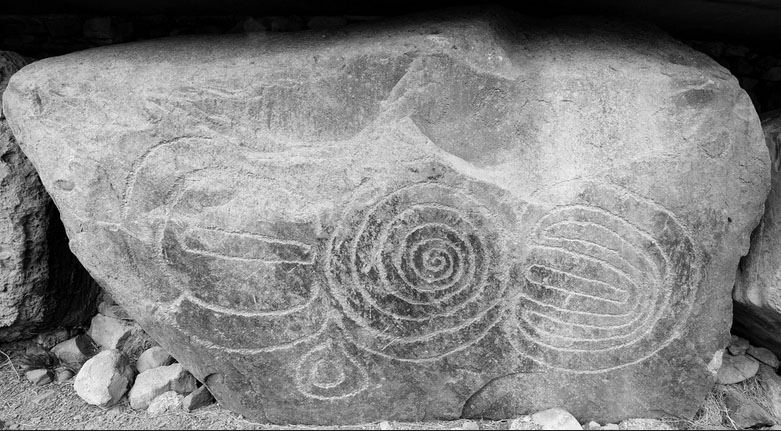
On Knowth kerbstone 5 are some very interesting designs. To the right are horns. Centrally is a single spiral. To the left is very familiar variation on the labyrinth theme that is generally attributed to the Greeks and the myth of the Minotaur. Each of the 3 main designs suggest circuitous pathways, movement and exploration.
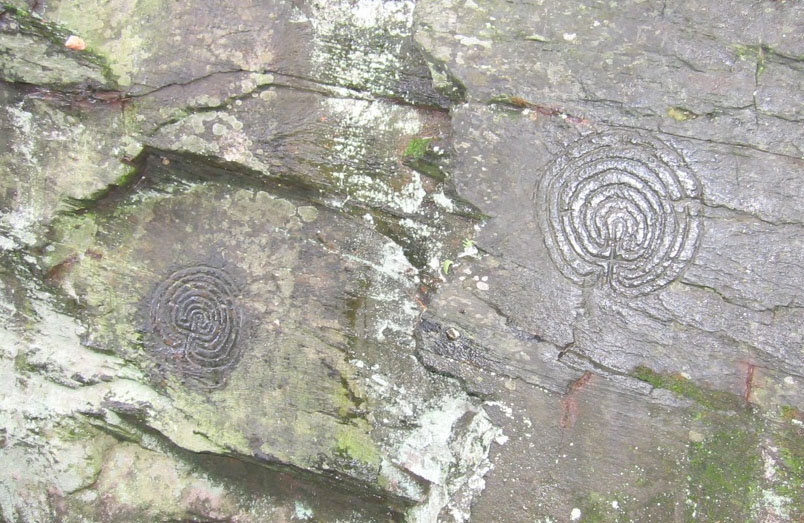
The labyrinth design is far older than the Greeks and these incised examples at Rocky Valley, North Cornwall, England might date to as much as 3000 BC, or 2000-years before the emergence of the Greek civilisation. Athens, in Greece, was founded by the mysterious "Sea People" in about 1200 BC during the Greek dark ages, who also introduced a pantheon of Celtic gods, like Athena, goddess of wisdom, myths, sciences and measurements. From these beginnings in Athens, civilisation slowly enveloped Greece.
But the story of the Minotaur and the labyrinth might be an allegory for what was happening at the great open-air-universities of Avebury Henge, Durington Walls Henge in Southern England, Brodgar in Scotland of the vast complex fanning out from the Boyne River Valley in Ireland.
Consider the following points from the Minotaur and labyrinth myth:
1. Groups of 7 young men and 7 unwed young women (from Athens) were periodically (each 7 or 9-yrs) assigned to descend into the underworld of the labyrinth as sacrificial victims, destined to meet a terrible death, if they were unable to outwit and escape the dreaded, horned Minotaur that lurked below.
2. The Minotaur was half sea monster, half human, with an insatiable appetite for human flesh.
3. The Minotaur was so dangerous that a highly complicated labyrinth maze had to be designed and built to contain him.
4. The only hope the sacrificial victims had to escape was to navigate through the maze successfully, but if they got lost, certain death awaited them from the stalking Minotaur.
5. Theseus entered into the labyrinth, having been taught its complex design layout by the architect who built it, and marked his path or journey with a ball of string, such that he could retrace his steps back to the entrance later.
6. Theseus found and slew the Minotaur then, following the string-marked path, navigated his way back to safety through the portal to the overworld above.
Labyrinths and mazes have always held a particular fascination for the people of the British Isles for the past 5000-years, and, as compelling historical evidence supports, they became the "Sea People".
Students at the Boyne River Valley open-air-university would eventually have to face the dreaded sea monster, with his hunger for human flesh. They had 7-9 years to learn how to navigate the regional labyrinth, designed by astronomer-navigator architects, and, despite the elements, retrace their twist & turn steps safely back to home base.
Gaining profound skills in the navigational arts was the only hope the students had of staying alive when they finally left terra firma to go to sea in ships. The dangerous sea was no respecter of persons, did not abide fools at all well and was hell-bent on swallowing-up all humans who entered the realm without sufficient knowledge or stamina to endure the elements, find a destination, then retrace their steps back to safe-haven and a hero's welcome.

The snake-like meandering, zigzagging, spiraling-out in ever increasing circuits, all seem indicative of voyaging about the landscape from site-to-site and learning navigation from every conceivable angle or approach ... which is what a navigator-sailor would need to know. The zigzag configurations would be in similitude to tacking on the wind in a ship at sea, back & forth across a leyline to a destination.
SO, WITH ALL OF THIS ACCRUED NAVIGATIONAL KNOWLEDGE, DID THEY MANAGE TO GET ANYWHERE?
The answer to that question is a resounding YES!
Their structures, using the same distance and angle codes, are found in profusion across North and South America and across the Pacific Ocean to the very ends of the Earth in New Zealand.
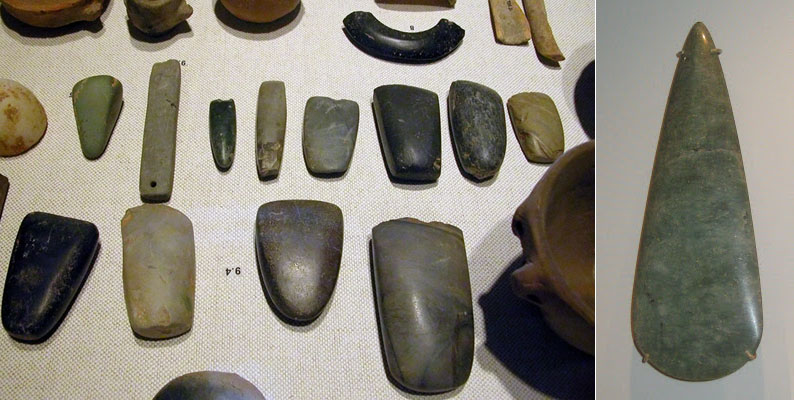
Left: The ancient people of the British Isles and greater Europe were advanced artisans in the fabrication and fine polishing of hardstone tools.
Right: They excelled in the cutting, shaping and and polishing of very hard jade-stone, which they also venerated as a treasure or article of prestige and high office.
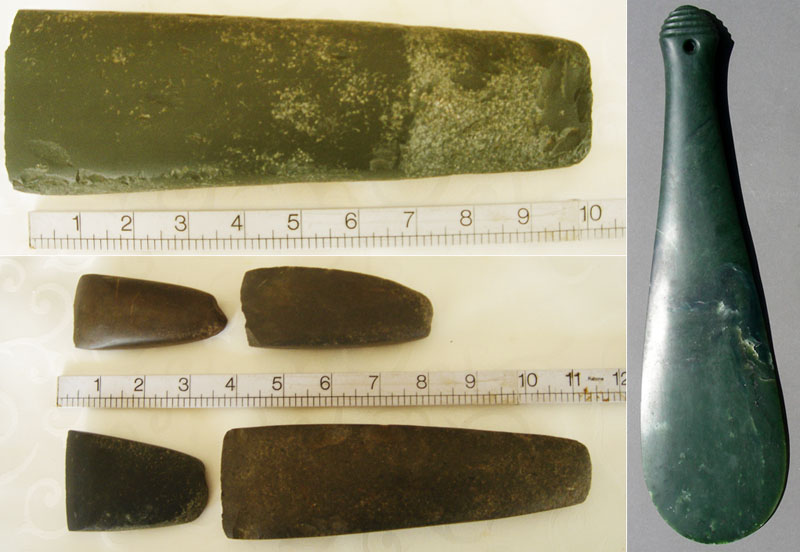
The early Neolithic voyagers ranging across the the length & breadth of the Pacific Ocean brought their adze and stone tool making expertise with them, including the advanced art of fabricating a wide variety of beautiful objects in very hard New Zealand greenstone, which they venerated as a treasure or article of prestige and high office. The greenstone club shown is of the same design as some found in Peru, South America, where upwards of 10,000 very ancient Caucasoid-European mummies, with red or blond hair, etc., have been exhumed so far.
Don Mariano Edward Rivbro (Director of the National Museum of Peru) and Juan Diego de Tschudi (Member of various scientific societies in Europe and America) wrote the book Antigüedades Peruanas (Peruvian Antiquities) in 1850, and stated:
'It is worthy of note that among the clubs there was one, the form of which is completely identical with that which is used by the inhabitants of New Zealand and other islands of the Pacific' (see Peruvian Antiquities, page 212).
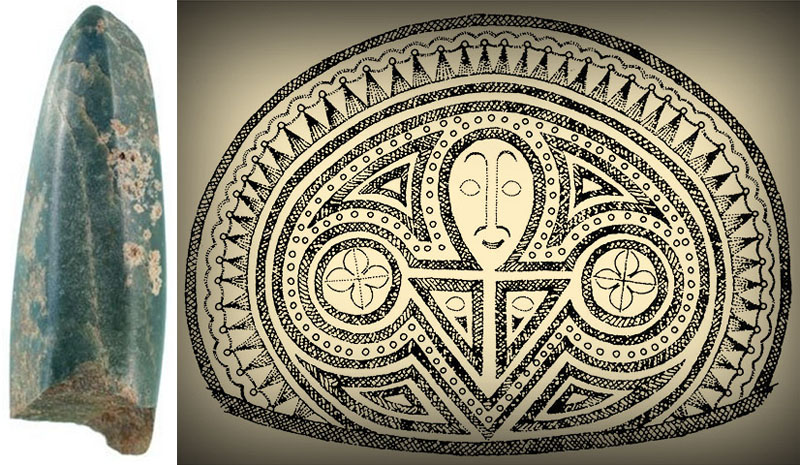
One jadeitite wood-gouge recently discovered on a coral island in Papua, New Guinea has been dated at 3300-years old and the only known region where jadeitite specimens are found to contain similar chemical properties is in Baja California Sur, Mexico. The artefact is attributed to the Lapita people, who ranged through the Pacific Ocean for millennia before the epoch of the Polynesians.
The Lapita people created ornately designed pots, covered in knop, chevron, lozenge and double spiral features which duplicated designs on the kerbstones of Knowth, Newgrange & Dowth chambered mounds or patterns found on Wessex pots of ancient England. The above design from a Lapita pot shows a Lapita face, encompassed by an Egyptian Ankh cross. The face is long, with wide eyes, small mouth clench, and a leptorrhine nose, beneath which is a moustache ... all European or Caucasoid features.
It wouldn't be much of a stretch of the imagination to assume that 4-leaf shamrocks (4-leaf clovers) are being displayed on either side of the above figure. The 4-leaf shamrock was much revered by the later Druids and considered to be a source of protection or to have magical properties for clairvoyance.
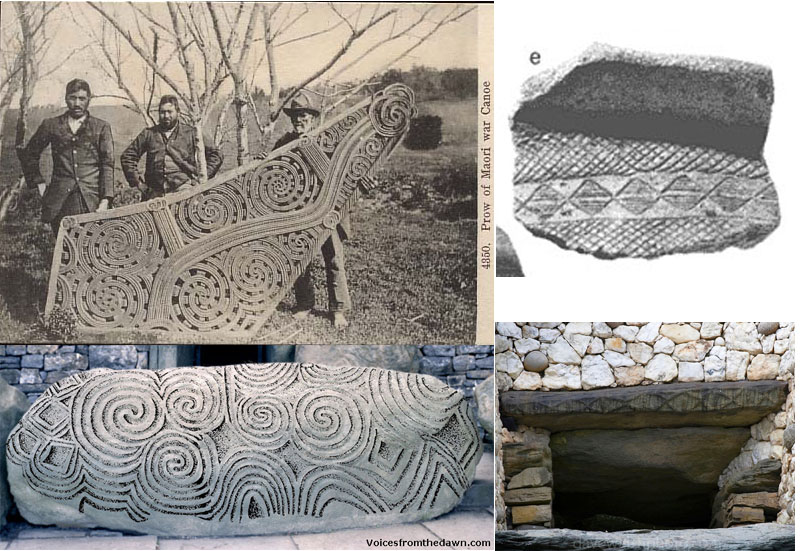
Ornately carved spirals adorn a carved prow from a Maori war canoe. Beneath it is shown the same kinds of double, returning spiral designs carved into a Khowth chambered mound boulder, but dating to about 3150 BC. Also, chevron and lozenge patterns are very prominently used in cultural symbolism throughout Polynesia and, especially, New Zealand. To the upper right is seen a lozenge string on a fragment of Lapita pottery. Below it is seen the window lintel at Newgrange chambered mound, adorned with the same kind of lozenge string.
The Lapita skeletons, when found, just like the ancient, pre-Maori skeletons that were once abundant in New Zealand burial caves or sand-dunes, are not allowed to be studied or forensically tested.
'Unable to research genetic variations in ancient people, she turned to the next best thing - rats. Matisoo-Smith and a colleague, J.H. Robins, examined the variations in mitochondrial DNA of ancient and modern samples of a rat species, Rattus exulans, from Bougainville, New Britain and other Polynesian islands. This species was used as food by the Lapita people in their outrigger canoes when they settled parts of Oceania roughly 3,000 years ago... Ancient human remains in the Pacific are rare and off-limits for study, Matisoo-Smith said, so there was no hope of comparing genetic variations in old and new human tissue'. (See: New Zealand Herald, 26/6/2004).
Similarly, when a complete, very tall, Lapita skeleton was found in 2002, this was the politically-correct result:
"Patrick Nunn, the supervisor of the archaeological team analysing the remains at USP would not comment and said on Sunday "we have decided to keep our find under wraps". 14 July 2002.
THE CAUCASOID EUROPEAN STATUES OF EASTER ISLAND.
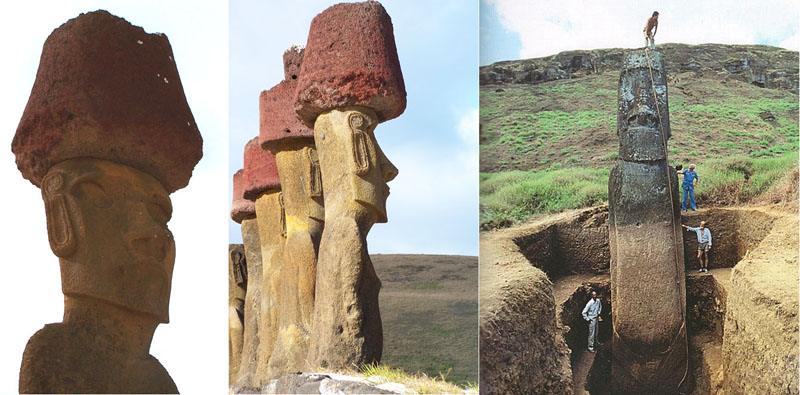
The long thin faces of Caucasoid Europeans with the dolichocephalic cranial (cephalic) index, narrow beaked leptorrhine nose type, wide eyes, thin lips, small mouth clench and prominent chin (the sharpened edge aspect to indicate a full beard) without any indication of chin prognathism.
The jawline on the lower border of the mandible is very flat or curves slightly upwards, consistent with a European jaw, whereas the Polynesians predominantly display the "Rocker Jaw", with it's continuous, pronounced downward curve on the lower border. The "Rocker Jaw" is the singly most important identifying feature of Polynesian physiology, occurring in up to 92% of cases. It's incidence at Easter Island amongst the native population is the lowest in Polynesia, showing that there was an early era admixture of a distinctly different racial type that came into the local Polynesian gene pool. This occurred long before modern day explorers found Easter Island in the 1700's and relates to early intermingling with the white, long-eared people encountered when the first Polynesians arrived.
The stone chosen to form the body of each statue is a tawny or very light tan colour, consistent with European skin colouration in sunny conditions. The question goes begging: Why would Polynesians laboriously carve and erect many hundreds of huge, hefty statues displaying physiological features of an altogether different racial-type, which bore no resemblance to their own people or revered ancestors? Why would they go to such trouble to make sure that each ancestor had "red hair" top-knots (hair pulled together and knotted) by quarrying that special coloured lava stone (red volcanic ash or tufa) from one isolated location (Teraai Hills) on the island. Some top-knots alone weighed 20-tons and have been transported to the most extreme coastal positions of the island to adorn the statues they were carved for.
To the right is seen just how much silt build-up has occurred since the statues were first placed upon their foundations, and yet we are supposed to believe that these many hundreds of statues were laboriously quarried and shaped by Polynesians, transported overland for several miles and stood up on their platforms as little as 1200 - 1500-years ago.
A New Zealander looking at the kerbstone art of Knowth, Newgrange & Dowth, etc., would immediately recognise it as duplicating, what is regionally called, at the base of the South Pacific, Maori cultural symbolism.
IRISH BULLAUN BOWLS OF THE SOUTH PACIFIC.
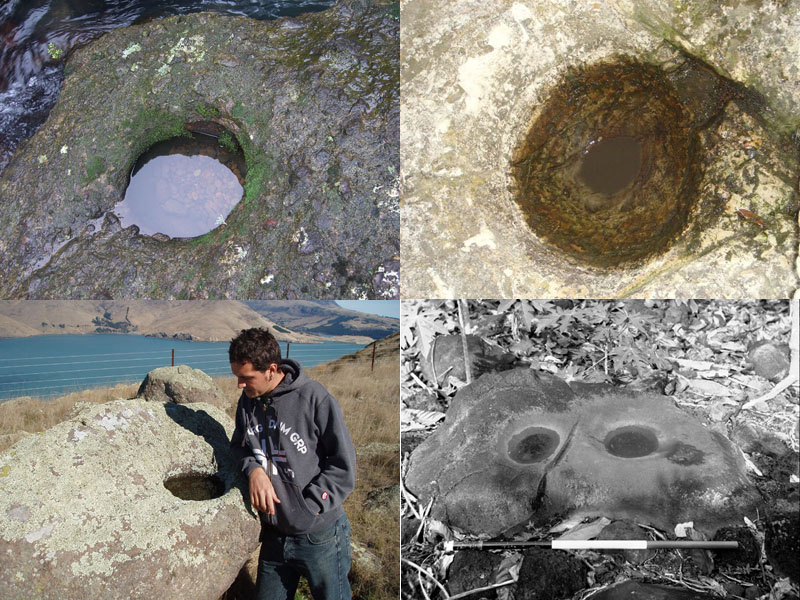
Another of many very ancient and reasonably exclusive cultural idiosyncrasies, brought to New Zealand from the Northern Hemisphere, is laboriously hewn-out bullaun boulders to form blessing and cursing altars. These self-same bullaun altars are found all over Ireland and, to a much lesser degree, in other parts of the British Isles and Continental Europe. In essence, bullaun bowls are a very Irish ritual expression.
The bullaun bowls displayed in the above pictures are from New Zealand, except the one at the bottom right, which is in Samoa. Bullauns, like these, are found throughout New Zealand in both the North and South Islands.
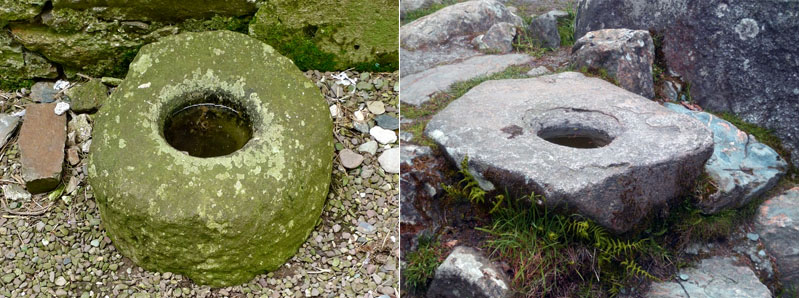
Here are a couple of examples of the bullaun bowls that are found all over Ireland, which were formerly for prayers, ritual washing, blessing & cursing by ancient Neolithic peoples until well into the Christian era. The Pagan use of bullauns merged into Christian usage and the church adopted them, at some point, as baptismal fonts and receptacles of holy water.
And the line-up of evidence goes on & on interminably, but suffice it to say that Maori oral traditions clearly state that, upon arrival in New Zealand, it was found that there was a large, well-established population already living in the country. The inhabitants were described as having skin complexion that was white to light-ruddy, with eye colours from blue to green to darker tints. Their hair colours ranged from white, blond, red, brown & black, with red being predominant in the general population. Here are a few quotes:
“The Maoris used to pay great respect to the bones of their dead, yet here and there may be found among sandhills, etc., human remains uncovered by the wind, and of these no tradition remains, as there would certainly be if the relics were those of ancestors. The natives say, “These are the bones of strangers.” So also mortuary-caves are found concerning the contents of which the Maoris make the same remark, and regard them with indifference (See, The Maori Race, by Edward Tregear, pp. 562-563).
“Generally speaking, Ngati Hotu were of medium height and of light colouring. In the majority of cases they had reddish hair. They were referred to as urukehu. It is said that during the early stages of their occupation of Taupo they did not practice tattooing as later generations did, and were spoken of as te whanau a Rangi (the children of heaven) because of their fair skin. There were two distinct types. One had reddish skin, a round face, small eyes and thick protruding eyebrows. The other was the Turehu. They had white hair and blue green eyes. They were fair-skinned, much smaller in stature, with larger and very handsome features.” (Tuwharetoa, Chpt. 7, pg. 115, by Rev. John Grace).
'The Maori regales us with several tales that are supposed to illustrate a period when the Maori people were living here on sufferance, as it were, under the mana [authority - rule] of the Turehu or Patu-paiarehe, the true lords of the soil. Many different names are used to denote this forest folk or fairies as our writers often term them, though the Maori concept is not that of a diminutive fey or elf like folk, but rather that of a people of ordinary stature and appearance, save they are said to have been fair-skinned and fair haired' (see Maori Religion, by Elsdon Best).
These ancient New Zealanders set up standing stone circles, solar observatories, trig mounds on hill ranges, obelisk survey markers, hill-forts built in the pre-Celtic palisaded style, defensive enclosures riddled with souterrain tunnel systems, souterrain houses, gable-roofed houses, stone beehive houses, canal systems, vast networks of overland walkway systems, irrigation systems, bullaun altars, etc., etc., all of which later came into the possession of Maori as the spoils of conquest. In the early centuries after the arrival of the Polynesian-Maori, these more ancient inhabitants, who had occupied New Zealand for thousands of years, taught Maori such things as fish-net making, line-dancing, the art of facial tattooing, wood carving in the archaic styles of the Mediterranean, Continental Europe and the British Isles, as well as many forms of arts, crafts, weaving, games, oratory, music, fishing by the moon, etc., etc.
And, of course, they brought their gods, including Taranis (rendered
locally using the Scottish derivation Taranaich)
in whose honour they aptly named a majestic, active volcano, Taranaki.
In the regional vernacular or dialect evolving in isolation, all words had
to end with a vowel, hence Taranaich was rendered Taranaki and
an ancient totem bearing his lightening bolt, double-spirals and thunder wheel-cross
or sun-cross is preserved in a New Zealand museum.
However, in New Zealand academic circles, these ancient people are not allowed to be remembered and considerable effort is made to expunge them from memory and history.
Martin Doutré, 10/10/14. ©